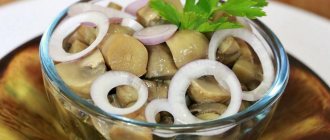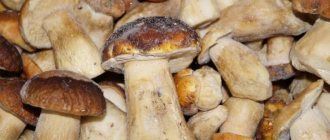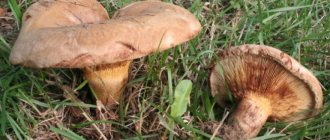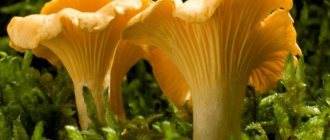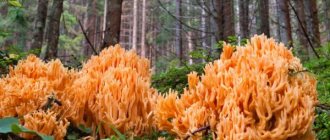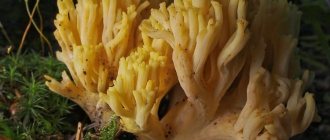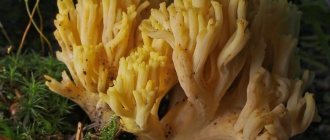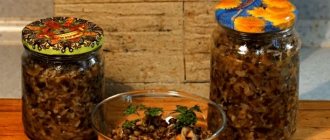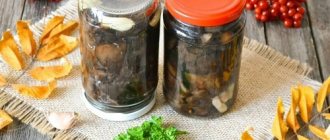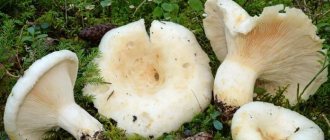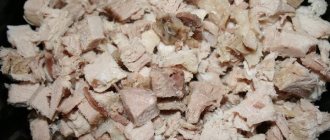How to cook horned mushrooms: recipe
The horned mushroom or deer horns belongs to the 4th category of edibility. First, it is boiled for 30-40 minutes, and then stewed or fried.
How to cook horned potatoes with potatoes
The mushroom picking season begins in mid-summer and ends in October. Young plants are eaten before they begin to taste bitter. Before cooking, it is better to soak the slingshots for half an hour to get rid of adhering sand and soil.
Preparation:
- Boil the mushrooms in salted water for 2 times for 15 minutes, drain the broth.
- Cut the slingshots into small pieces. Fry them for 15 minutes in vegetable oil.
- Add diced potatoes, salt and spices. Stir the ingredients and cook with the lid closed for another 15 minutes.
Serve the dish with sour cream and dill.
Recipe for horned mushroom and spinach soup
A fragrant and satisfying dish can be served with white bread croutons.
Ingredients:
- slingshots – 200 g;
- water – 2 l;
- spinach – 100 g;
- potatoes – 3 pcs.;
- carrots – 1 pc.;
- onion – 1 pc.;
- celery root – 60 g;
- vegetable oil – 60 g;
- greens – 1 bunch;
- bay leaf – 1 pc.;
- salt and pepper - to taste.
How to cook:
- Boil the mushrooms for a quarter of an hour, drain the broth. Rinse the preparations and boil them again.
- Divide the workpieces into fibers.
- Cut the carrots, onions and celery into strips, and the potatoes into cubes.
- Fry the vegetables in vegetable oil until golden brown, add mushrooms to them. Simmer food for 10 minutes.
- Pour in water and bring it to a boil. Add potatoes and spices, cook until vegetables are done.
- Place the sliced spinach and bay leaf into the pan. Cook the dish over medium heat for 5 minutes.
Before serving, garnish the soup with chopped herbs.
Horntail mushrooms with soy sauce and garlic
The spicy appetizer can be served with boiled or fried potatoes.
Ingredients:
- slingshots – 600 g;
- soy sauce – 60 g;
- vegetable oil – 60 g;
- red onion – 1 pc.;
- green onions – 1 bunch;
- garlic – 2 cloves.
Cooking steps:
- Place the slingshots in boiling water and cook them for 20 minutes. Drain the broth and repeat the procedure.
- Cut the mushrooms into small pieces or separate them into fibers with your hands.
- Fry the pieces over high heat for 5 minutes, then pour in the soy sauce and reduce the heat. Simmer the mushrooms under a closed lid for another 7-10 minutes.
- Chop the green onions and cut the garlic into thin slices. Mix the prepared products with mushrooms.
The dish can be served hot or chilled.
Boiled and fried deer horns resemble chicken meat. After heat treatment, they retain a bright mushroom aroma.
Marinade for mushrooms - how to make pickling brine for the winter?
Mushrooms cooked in an original marinade are a real treat in winter. Fragrant and crispy fruits will perfectly complement any, even the most sophisticated holiday table. The marinade for mushrooms should be selected based on the type of harvest and individual taste, however, there are several universal, proven recipes that are worth adopting.
Selection and preparation of mushrooms for pickling
Almost all edible and some conditionally edible mushrooms are suitable for pickling. The following types are popular today:
- Champignon;
- White mushrooms;
- boletus;
- Russula;
- boletus;
- boletus;
- chanterelles;
- saffron milk caps.
Young and strong fruits are chosen for harvesting for the winter.
Damaged areas are cut off, and it is advisable to throw away wormy specimens. The crop is cleared of debris and washed thoroughly. If the mushrooms are small, then they are used whole, and large ones are cut into several parts. When preparing some mushrooms, for example, umbrellas, oyster mushrooms, the stems are cut off from the caps. Preliminary preparation of butter includes removing the top layer of skin. Before cooking, the milkweed is soaked in water from several hours to three days, which allows you to get rid of the bitterness of the milky juice.
All varieties must undergo heat treatment, which is an excellent prevention of poisoning and prolongs the suitability of the dish. Chanterelles, honey mushrooms and boletus caps, the flesh of which is dense, are boiled for 20-30 minutes. Kozlyaki, boletus and boletus are boiled for no more than 15-20, after adding salt to the water.
Classic marinade recipe per 1 liter of water
Mushrooms marinated according to this recipe go well with potatoes. They can be served as an independent snack, added to salads and toppings. For 1 liter of water prepare the following components:
- 2 kg of boiled mushrooms;
- 4 tsp. salt;
- 2 tbsp. l. Sahara;
- three sticks of cinnamon and bay leaves;
- 6 pcs. black pepper;
- 3 tsp. vinegar essence;
- 4 cloves.
Place all the necessary ingredients, except vinegar essence, into boiling water.
The liquid should boil for about three minutes, then add the essence and remove from the stove. Cooled boiled fruits are laid out in glass containers at 2/3 of the height. The jars are filled with marinade and the lids are tightly screwed on.
A universal recipe for brine per 1 liter of water for wild mushrooms
This brine recipe is suitable for most types of mushrooms. The procedure includes the following ingredients:
- 1 liter of water;
- 1 kg of mushrooms;
- teaspoon of citric acid;
- 1 tbsp. l. salt and sugar;
- spices are added to taste.
The forest harvest is washed, and too large fruiting bodies are cut into 2-3 parts. The required amount of water is poured into the container, all ingredients (except citric acid) are added along with the mushrooms. Remove the foam from the boiling liquid and boil for 30 minutes. After this, pour citric acid into the container.
You should be careful because the acid creates a lot of foam when it gets into boiling water.
After a few minutes, the mushrooms are removed from the heat and left for 12 hours with the lid ajar. The finished product is packaged in jars and filled with the remaining brine; it can be stored in the refrigerator.
Rogatik coral-shaped. Rogatiki mushrooms
Rogatik is the common name for basidal fungi.
General description The fruiting bodies are erect, rod-shaped, club-shaped or branched in the form of a bush. The color is white, gray, yellow, cream and other colors. Inhabits forests on soil, litter and rotten wood. Many are edible, but are not usually collected by the public. There are no poisonous ones that are dangerous to human life. But there are inedible ones, with a bitter taste or unpleasant odor.
Rogatiki:
Conditionally edible
Ramaria yellow
Lat:
Ramaria flava
Synonyms: Yellow stag, Bear paw, Deer horns, Yellow coral.
74307
10
Clavicorona flap-shaped
Lat:
Artomyces pyxidatus
Synonyms: Artomyces vitreous, Clavicorona box-shaped, Deer horns, Mushroom cabbage, Mushroom noodles, Clavicorona pyxidata.
15259
15
10412
5
Ramaria vulgare
Lat:
Ramaria eumorpha
Synonyms: Invala hornet, Spruce hornet, Ramaria Invalii, Clavaria invalii, Clavariella eumorpha.
Light ocher, yellowish bushes of Ramaria Intvala are often found in coniferous forests; this is one of the most common types of ramaria.
Characteristics:
- Shape: coral-shaped
7022
2
Clavulina coralliformes
Lat:
Clavulina coralloides
Synonyms: Clavulina cristata, Clavulina cristata.
Headings: K, Inedible mushrooms
6781
3
In coniferous or mixed forests, height 7-12 and thickness 1-3 centimeters
Characteristics:
- Shape: club-shaped
6230
2
Narrow, tall: up to 10-15 cm tall, up to 1 cm thick at the widest part. In deciduous and mixed, you need oak, aspen, birch.
When and how to collect?
When collecting, you should be extremely careful, because among the horned ones there are many poisonous look-alikes. Edible corals are collected and prepared from August to September inclusive. During this period, they can be found in the undergrowth in single “bushes” or groups of several hornets. And in the southern part of the country they are collected even in winter.
There are several rules that should be followed when collecting yellow ramaria:
- Old mushrooms should not be cut off, because they have a bitter taste. Only young cattails are collected.
- It is better to avoid suspicious corals, especially those that grow on stumps. Outwardly they look like cattails, but are actually poisonous. The conditionally edible Calocera adhesive also lives on dead wood and stumps.
- If the coral grows near the road, it is better to leave it. He, like most representatives of the mushroom world, is capable of absorbing exhaust gases, dust and other harmful substances. It is advisable to collect mushrooms in environmentally friendly places.
Advice!
A package or bag is not suitable for mushroom hunting, because during transportation the harvest will turn into one sticky mass. It is better to take a wicker basket with you, which will perfectly preserve the attractive appearance of the mushrooms.
How to clean deer antlers. Botanical description
Staghorn mushrooms resemble coral branches or deer antlers in appearance. The photo shows a clear resemblance. The aboveground part of the plant is very branched and decorative. The spines are snow-white, 10 to 20 mm high. The body diameter of the mushroom is 16-30 cm; specimens weighing up to 1 kg are found in nature. It is worth noting that most often the height and width of the exotic mushroom are the same. The branches of the plant are thin and quite brittle. The coral hedgehog only affects the wireworm; other worms are indifferent to it.
The color of the mushroom changes as it grows, acquiring characteristic yellow shades. Obsolete copies may be bright orange. Horntails and amethyst colors grow. The active growing season of basidiomycetes falls from June to October. The biological culture does not have the usual mushroom aroma; in its raw form, the deer horn mushroom has an elastic consistency; when cooked, the fruiting body becomes harsh.
The most commonly mentioned mushrooms can be seen on tree trunks and stumps. Like other woody lower plants, they are not difficult to notice on rotten wood of any species. It is believed that among a certain variety of coral-shaped mushrooms there are no poisonous ones, while there are plants that are conditionally inedible and suitable for consumption. It is better to use young species of deer antlers for food. Large hedgehogs can disappoint with their taste: they are bitter and have an unpleasant aftertaste.
The best collection period is August and September; in the southern regions of our country, slingshots are also collected in winter. They often grow in whole clusters; collecting such mushrooms is an endless pleasure. Knowing the description of edible cattails, you can easily prepare the required amount of forest product and prepare wonderful dishes.
Deer horns - how to cook mushrooms at home for the winter
“Deer horns” are very unusual mushrooms at first glance, and that alone makes them attractive. The product got its name due to its bizarre shape. From a distance it may even seem that real sea corals grow in the thicket of the forest. But in fact, these are edible and very healthy mushrooms that can be prepared in a very original way at home.
This is interesting: slingshots are actively used in Chinese medicine to treat gastrointestinal diseases. It is also believed that this product has a beneficial effect on lung function, reduces the risk of developing cancer and stimulates the immune system.
You will definitely surprise your family when you serve salted “corals” on the table. If you are interested in the question of how to pickle “deer horns” mushrooms for the winter, know that it is best to use a young mushroom body, since overripe horns can taste bitter. The degree of ripeness of the fruit is determined by its color - the older it is, the more clearly the rich orange hue appears. It’s good if you get a light yellow product. This mushroom can be safely used for pickling.
When salting “deer horns”, no additional seasonings or spicy spices are usually used. This allows you to preserve the unique delicate taste of “coral”.
Important: before storing mushrooms in the cellar for pickling, make sure they are completely covered with brine. If there is not enough liquid in the container, add the required amount of cool boiled water. It is also necessary to change the piece of fabric from time to time for a clean one and ensure that mold does not appear.
Our article discusses in detail the question of how to prepare “reindeer horns” mushrooms for the winter quickly, simply and guaranteed to be tasty. At the same time, this delicate product is used in various ways in cooking. It can be fried, pickled, stewed with vegetables or added to aromatic first courses. As a result, you will always get a delicious dish with exquisite ingredients.
Surprise yourself and surprise your family by learning different ways to prepare “reindeer horns.”
Did you like the recipe? Save it to your Pinterest! Hover over the image and click “Save.”
Mushroom bagels. Horny Mushroom Recipes
- The horned mushroom or deer horns belongs to the 4th category of edibility. First, it is boiled for 30-40 minutes, and then stewed or fried.
- Number of servings: 3
- Preparation time: 30 minutes
- Cooking time: 30 minutes
The horned mushroom grows in coniferous and mixed forests.
Photo: Getty
How to cook horned potatoes with potatoes
The mushroom picking season begins in mid-summer and ends in October. Young plants are eaten before they begin to taste bitter. Before cooking, it is better to soak the slingshots for half an hour to get rid of adhering sand and soil.
Preparation:
- Boil the mushrooms in salted water for 2 times for 15 minutes, drain the broth.
- Cut the slingshots into small pieces. Fry them for 15 minutes in vegetable oil.
- Add diced potatoes, salt and spices. Stir the ingredients and cook with the lid closed for another 15 minutes.
Serve the dish with sour cream and dill.
Recipe for horned mushroom and spinach soup
A fragrant and satisfying dish can be served with white bread croutons.
Ingredients:
- slingshots – 200 g;
- water – 2 l;
- spinach – 100 g;
- potatoes – 3 pcs.;
- carrots – 1 pc.;
- onion – 1 pc.;
- celery root – 60 g;
- vegetable oil – 60 g;
- greens – 1 bunch;
- bay leaf – 1 pc.;
- salt and pepper - to taste.
How to cook:
- Boil the mushrooms for a quarter of an hour, drain the broth. Rinse the preparations and boil them again.
- Divide the workpieces into fibers.
- Cut the carrots, onions and celery into strips, and the potatoes into cubes.
- Fry the vegetables in vegetable oil until golden brown, add mushrooms to them. Simmer food for 10 minutes.
- Pour in water and bring it to a boil. Add potatoes and spices, cook until vegetables are done.
- Place the sliced spinach and bay leaf into the pan. Cook the dish over medium heat for 5 minutes.
Before serving, garnish the soup with chopped herbs.
Horntail mushrooms with soy sauce and garlic
The spicy appetizer can be served with boiled or fried potatoes.
Ingredients:
- slingshots – 600 g;
- soy sauce – 60 g;
- vegetable oil – 60 g;
- red onion – 1 pc.;
- green onions – 1 bunch;
- garlic – 2 cloves.
Cooking steps:
- Place the slingshots in boiling water and cook them for 20 minutes. Drain the broth and repeat the procedure.
- Cut the mushrooms into small pieces or separate them into fibers with your hands.
- Fry the pieces over high heat for 5 minutes, then pour in the soy sauce and reduce the heat. Simmer the mushrooms under a closed lid for another 7-10 minutes.
- Chop the green onions and cut the garlic into thin slices. Mix the prepared products with mushrooms.
The dish can be served hot or chilled.
Boiled and fried deer horns resemble chicken meat. After heat treatment, they retain a bright mushroom aroma.
Recipe: Salted mushrooms - from boiled frozen
I usually freeze fruits and vegetables for the winter.
This is the fastest and can then be used in different variations at any time. This also applies to mushrooms. I freeze about 10% raw, and fry or boil the rest with a minimum amount of water so that they take up less space.
Then I put it in milk cartons (or any containers), freeze it, and cook soups all winter or “pickle” them in literally fifteen minutes.
I learned this method many years ago and now I don’t waste time on classic salting, marinating and all these labor-intensive processes.
Now I’ll tell you how easy it is to prepare salted mushrooms in the right quantity in a quarter of an hour.
I usually do everything by eye, but for this review I specially weighed a bag of mushrooms, it’s approximately 800-900 grams together with the broth (there’s not much of it at all).
Ideally, it is better to defrost the mushrooms in advance, but it is not forbidden (if you suddenly want to) immediately remove them into a saucepan, where they will be cooked:
To make the mushrooms aromatic and spicy, you will need to take several peas of black and allspice, three or four buds of cloves, a couple of bay leaves, a handful of dried dill (umbrellas and sticks - everything will work here), a few cloves of garlic and half a tablespoon of salt:
Place the mushrooms on the fire and wait for them to boil. And at this time you need to place all the spices in gauze and tie them in a knot.
This is so as not to throw it all into the mushrooms and then spit it out. It's simple:
Salt the boiled mushrooms (salinity should be sensitive):
And we place our bag in the mushrooms:
Leave the tip of the knot on the rim and cover with a lid:
All this simmers over low heat for ten minutes. In the meantime, cut the garlic into slices:
And throw it into boiling mushrooms:
Stir and leave to cook for exactly five minutes:
All is ready. We extract, slightly squeezing, the bag of spices:
and wait until the mushrooms cool down. There was very little broth:
And when cold, the entire mass of mushrooms becomes dense:
You can eat them just like that, they are very aromatic and tasty. Or you can cut the onion, pour some oil on it, and the appetizer is ready:
I recommend trying it if you have frozen boiled mushrooms.
I indicate the time without taking into account preliminary defrosting and cooling time.
Deer beard mushroom. Yamabushitake (Crested hedgehog)
Yamabushitake, also known as lion's mane mushroom, is a dietary mushroom that can be used as a dietary supplement. Appears to be a cognitive enhancer and immunomodulator (thought to be able to stimulate or suppress inflammation, depending on various factors).
Helpful information
Other names
Hericium erinaceus, lion's mane, monkey's head, hautougu (rare), comb gooseberry, Pom-Pom mushroom, hedgehog mushroom, grandfather's beard. Notes
- Since the water-soluble extract is considered less potent when taken alone, it is best to take yamabushitake in dietary supplement form directly with food.
Skin irritation may be caused by nerve growth factor and without signs of allergy is not dangerous
Variety
Currently, only one trial has been conducted with 1000mg yamabushitake (96% pure extract) taken orally three times daily. Although it is unknown whether this dosage is optimal, it appears to be effective.
Origin and composition
Origin
Yamabushitake, a mushroom that grows on old or dead deciduous trees, is consumed in Japan and China, without any harmful effects on the body. Some common names: monkey's head, lion's mane and grandfather's beard, sometimes called hautougu, like a drink for athletes with containing Hericium erinaceus (11th Asian Sports Festival in China, 1990).
Compound
- Erinacines A-K
Orcinol derivatives (mycelium)
Sialic acid binding lectin
Sterols such as ergosterol and beta-sitosterol.
And also the polysaccharide component (Hericium erinaceus) - polysaccharides called HEF-P and belonging to the beta-glucan family can be broken down into 4 polysaccharides. The percentage in the fruiting bodies is approximately 20%, 18.59% ethanol extract and the general structure of these polysaccharides includes xylose (7.8%), ribose (2.7%), glucose (68.4%), arabinose (11.3%), galactose (2.5%) and mannose (5.2%) Like most mushrooms used for medicinal purposes, yamabushitake appears to contain bioactive polysaccharides (carbohydrates) along with ethanol-soluble molecules. The total phenolic content of yamabushitake is 10.20 +/- 2.25 mg gallic acid equivalents per gram (about 1%) with hot water extract, which appears to be five times higher than when cooked in the oven, using methanol or in lyophilized fruiting bodies. This phenolic content of 10.20 +/- 2.25 mg gallic acid equivalents per gram is significantly less than in the quercetin preparation (194.24 +/- 7.58) and in general in laboratory studies has an anti-inflammatory effect Yamabushitake was more than 5 times lower than that of quercetin. The polysaccharides themselves are active in the laboratory, and taking 300 mg/kg of polysaccharides per day for 15 days can help reduce inflammatory processes caused by ischemia or reperfusion. The phenolic anti-inflammatory potential of yamabushitake is significantly lower than that of the drug quercecin and gallic acid, but the polysaccharide component appears to be bioactive.
How to properly freeze mushrooms for the winter - freezing mushrooms at home
During the “quiet hunting” season, many people wonder how to preserve the entire harvest of mushrooms. A great way to do this is to freeze it. You can freeze both wild mushrooms and those you purchased in a store or market. After all, everyone knows that in the summer the price of mushrooms is much lower.
Porcini mushrooms, chanterelles, honey mushrooms, boletus mushrooms, oyster mushrooms, champignons and other types of mushrooms can be frozen at home. The general principle of freezing is the same for all mushrooms.
Sorting mushrooms after harvesting
First of all, mushrooms are sorted according to the structure of the mushroom. In this case, they distinguish:
- marsupials (truffles, morels);
- lamellar (for example, russula);
- tubular (ceps, boletus mushrooms).
It is preferable to freeze only tubular (or, in other words, spongy) mushrooms raw. The internal structure of the cap of such mushrooms is a porous surface, which, when boiled, absorbs a lot of liquid, and, as a result, the mushrooms will be watery when defrosted. If you had to boil sponge mushrooms, you should lightly squeeze them before freezing.
Lamellar types of mushrooms, such as honey mushrooms, must be boiled before freezing.
The few types of marsupial mushrooms must be boiled and thoroughly squeezed before placing them in the freezer.
How to prepare mushrooms for freezing
After sorting the mushrooms, the strongest specimens are selected for subsequent freezing.
Mushrooms are cleaned with a knife or a rough brush: all debris and stuck leaves are removed, the lower, contaminated part of the stem is cut off.
If the mushrooms selected for further freezing in their raw form are very dirty, then they should be rinsed in water, but under no circumstances soaked. Afterwards, they must be dried thoroughly with a paper towel.
Those mushrooms that you plan to boil can be safely washed under running water without worrying that they will absorb too much moisture.
Methods for freezing mushrooms for the winter
How to freeze raw mushrooms
As mentioned above, only tubular mushrooms are suitable for this freezing method. The ideal option would be porcini mushrooms and red caps.
Small mushrooms are frozen whole, and large specimens are cut into slices 1-2 centimeters thick.
Next, the mushrooms are laid out on a flat surface and put in the freezer for several hours. After the mushrooms have frozen, they are poured into a freezer bag or placed in containers.
See video from Lubov Kriuk - How to freeze porcini mushrooms
How to freeze boiled mushrooms for the winter
Mushrooms that will be pre-boiled must first be chopped. Next, they are immersed in boiling water and cooked for 5 to 10 minutes. Then place in a colander to allow excess liquid to drain. After the mushrooms have cooled, they are transferred into portioned bags for one use and sent to the freezer.
The broth from boiled honey mushrooms is drained, and from porcini and boletus mushrooms it is used to make soup.
See the video from the channel “Tasty and Nourishing” - How to freeze mushrooms for the winter
Freezing fried mushrooms
Both tubular and lamellar types of mushrooms are suitable for this method. Mushrooms are cut into pieces or plates. Then they are laid out in a frying pan with a small amount of vegetable oil and fried until golden brown. Salt and spices are not added. Roasting lasts approximately 20 minutes.
This frozen food is completely ready to eat after defrosting. You just have to add these mushrooms, for example, to fried potatoes or to a salad.
Freezing oven-baked mushrooms
Another way is to freeze mushrooms previously baked in the oven. To do this, mushrooms are placed on a baking sheet without adding oil and baked until cooked. Then they are put into bags and sent to the freezer for storage. Such mushrooms have a particularly bright taste and aroma when defrosted.
Freezing temperature and shelf life of frozen mushrooms
The temperature regime for freezing mushrooms is -18°C. If this requirement is met, mushrooms can be stored in the freezer all winter.
Ramaria mushroom. Yellow Ramaria (Ramaria flava)
A mushroom of an exotic species, nevertheless often found in forests, especially in the Leningrad region, rep. Karelia, Caucasus, Far East and Eastern Siberia. People also call it yellow hornet, coral mushroom, yellow coral. Gardeners can find the mycelium of this mushroom on sale for self-cultivation under the name Mushroom Noodles (from Chinese). Mushroom coral can be found from July until October, mainly in coniferous forests. It prefers moist, shaded places, but often grows abundantly in well-lit meadows. It can grow singly, in small groups and in large formations in the form of semi-rings.
The bushy yellow hornet actually looks like part of a coral. It can reach 25-30 cm in height with a total weight of 2-3 kg. Numerous, successively bifurcating branches extend from the thick base (which can be called the stalk). They are of equal length (comparatively long), highly branched, bush-like, fleshy, cylindrical or flattened, smooth, with blunt, irregularly truncated or jagged (often double) ends. At a young age, the branches are yellow, at a more mature age they can be painted in any shades of yellow: yellowish, apricot-, lemon-, sulfur-, dirty pale and gray-yellow, golden ocher or creamy, at maturity - ocher or orange . Closer to the so-called stem, the fruiting body is sulfur-yellow. The base itself is thick, 2 to 8 cm high, 4 to 5 cm in diameter, tapering downward. It is dense, whitish or yellowish in color (usually the same color with branches). It may be covered with reddish spots of varying sizes or darkens when pressed (to a reddish or wine-brown color). The pulp is white, off-white or yellowish, in the stem it looks like marble, at the break the color does not change or becomes reddish-brown. Watery, with a pleasant, slightly herbaceous odor, in youth fragile, soft, with a pleasant or insipid taste, with age it begins to taste bitter (especially the tops) and becomes rubbery.
Can be confused with other types of ramaria:
- golden (has a whitish base and shorter branches);
- with the weakly poisonous, beautiful tricolor ramaria (has yellow- and ocher-brownish branches (the main ones with a pinkish tint), with a bright pink stem in youth and whitish in maturity, with slightly bitter flesh);
The mushroom is edible. Young sprigs of horned grass are especially tasty in mushroom soups. You can salt it (pre-boil for 10 minutes before salting). In adults, the upper part of the branches may taste bitter, so they are usually removed.
